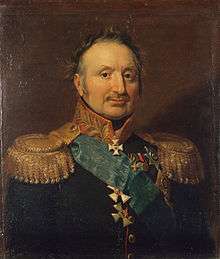Peter Wittgenstein
| His Most Serene Highness The Prince of Sayn-Wittgenstein-Berleburg | |
|---|---|
 Peter Fürst zu Wittgenstein. Portrait by George Dawe | |
| Born |
17 January 1769 Pereiaslav, Kiev Governorate, Russian Empire |
| Died |
11 June 1843 (aged 74) Lemberg, Austrian Empire |
| Buried | Camenca, Moldova |
| Allegiance |
|
| Service/ |
|
| Years of service | 1789 – 1829 |
| Rank | General-Field Marshal |
| Battles/wars | |
Ludwig Adolf Peter, Count (From 1834, Prince) of Sayn-Wittgenstein-Berleburg (German: Ludwig Adolf Peter Graf[1] (Fürst[2]) zu Sayn-Wittgenstein-Berleburg; Russian: Пётр Христиа́нович Ви́тгенштейн, Pyotr Khristianovich Vitgenshtein; 17 January [O.S. 6 January] 1769 in Pereiaslav – 11 June 1843 in Lemberg, Austrian Empire), better known as Peter Wittgenstein in English, was a Russo-German Military leader distinguished for his services in the Napoleonic wars.
Life
Born Ludwig Adolf Peter Graf zu Sayn-Wittgenstein-Ludwigsburg, he was descended from a family of independent counts whose seat was in Berleburg (present day North Rhine-Westphalia, Germany).
Military career
He was promoted to Major in 1793 of the Ukrainian light cavalry regiment. He fought with the unit in the Kościuszko Uprising. Promoted to the rank of colonel in 1798, and to major general in 1799, in 1800 he took command of the Mariupolski Hussars Regiment.
In 1805, he fought at Austerlitz, in 1806 against the Turks, and in 1807 against Napoleon at Friedland and against the Swedes in Finland.
In the war of 1812 he commanded the right wing army of the Russian Army, which he commanded in the First and Second battle of Polotsk. It was the battle that decided fate of Saint-Petersburg, and earned him the title of "Saviour of Saint- Petersburg".[3] Alexander I awarded him the Order of St. George. He tried to combine with Pavel Chichagov, at the Battle of Berezina, and later combined with the Prussian army corps under Ludwig Yorck von Wartenburg.
In the campaign of 1813 in January, he took over the command of the Russian army after Kutuzov's death, and commanded the Russian army at Lützen and Bautzen. But after the defeats of the Spring campaign, he laid down this command and led an army corps during the Battle of Dresden and Battle of Leipzig.
In the campaign of 1814, he led the 6th Corps under Schwarzenberg, and he was severely wounded at Bar-sur-Aube.[4]
In 1823 he was promoted Field Marshal, and in 1828 he was appointed to command the Russian army in the war against Turkey. But ill health soon obliged him to retire. In 1834 the King of Prussia gave him the title of Fürst (Prince) zu Sayn-Wittgenstein.[5]
Family
His parents were Count Christian Louis Casimir of Sayn-Wittgenstein-Ludwigsburg and his first wife Countess Amalie Ludowika Finck von Finckenstein.
On 27 June 1798 he married Countess Antonia Cäcilie Snarska and had in this marriage 11 children. He died on 11 June 1843 in Lemberg, where he looked after estates of his son Lev Petrovich.
References
- ↑ Regarding personal names: Until 1919, Graf was a title, translated as Count, not a first or middle name. The female form is Gräfin. In Germany since 1919, it forms part of family names.
- ↑ Regarding personal names: Fürst is a title, translated as 'Prince', not a first or middle name. The feminine form is Fürstin.
- ↑ Peter Khristianovich Napoleon.org
- ↑ http://www.napoleonsims.com/people/people.htm
- ↑

External links
![]()